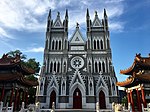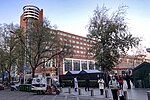Zhongnanhai (Chinese: 中南海) is a compound that houses the offices of and serves as a residence for the leadership of the Chinese Communist Party (CCP) and central government. It was a former imperial garden, and is located adjacent to the Forbidden Palace in Beijing. The term Zhongnanhai is often used as a metonym for China’s central government and its leadership at large.
The state leaders, including the president, general secretary of the CCP, and other top CCP and PRC leadership figures carry out many of their day-to-day administrative activities inside the compound, such as meetings with foreign dignitaries. China Central Television (CCTV) frequently shows footage of meetings inside the compound, but limits its coverage largely to views of the interior of buildings. Though numerous maps of the complex exist from before the founding of the People's Republic of China, the interior layout of Zhongnanhai has been altered significantly since then, including a wave of major renovations in the 1970s. Today many buildings share the names of older, pre-PRC structures, but have completely changed in layout and purpose. The complex is divided into two main sections, reflecting the parallel authority of the highest level of state and party institutions in the country. North Zhongnanhai is used as the headquarters of the State Council and includes the offices of its senior most leaders as well as its principal meeting rooms. South Zhongnanhai is the headquarters of the CCP Central Committee, including its staff and its highest level coordinating institutions, such as the Standing Committee, Politburo and Secretariat.
The current basic outline of Zhongnanhai emerged during the Ming dynasty when the southernmost of the two lakes in the complex was created in 1421. By the late Qing Dynasty, Zhongnanhai was used as the de facto center of government, with Empress Dowager Cixi and later Prince Regent Chun building residences there instead of the Forbidden City. After the establishment of the Republic of China, the new president, Yuan Shikai remodeled Zhongnanhai to become the formal center of what would become known as the Beiyang Government. In 1949, CCP Chairman Mao Zedong moved into the complex after the establishment of the People's Republic of China. Mao received many important foreign leaders in Zhongnanhai, including Nikita Khrushchev, Che Guevara, Richard Nixon, Georges Pompidou, Kakuei Tanaka and Zulfikar Ali Bhutto, among others. Mao's favorite places in Zhongnanhai were the Library of Chrysanthemum Fragrance (his personal residence, filled with bookshelves) and the Poolside House, next to the large indoor swimming pool, where he would spend much of the day swimming or reading books and reports by the pool. After Mao's death, the Chrysanthemum Library along with many of his belongings was preserved as a museum which is not accessible to the general public.











